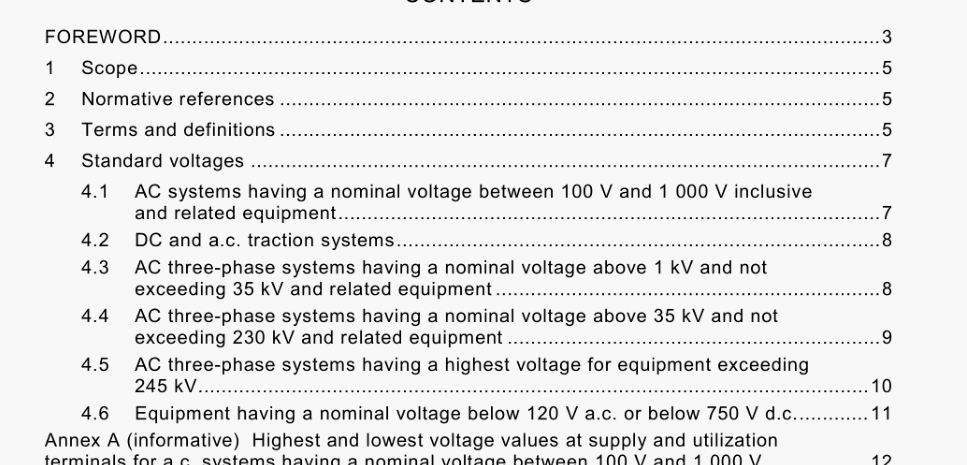IEC 60038-2009 pdf Tensions normales de la CEI

The values of nominal voltage (or highest voltage for equipment) specified in this standard are mainly based on the historical development of electrical supply systems throughout the world, since these values turned out to be the most common ones, and have achieved worldwide recognition; The voltage ranges mentioned in this standard have been recognized to be the most appropriate ones as a basis for design and testing of electrical equipment and systems. NOTE 2 It is nevertheless the task of system and product standards to define appropriate testing values, testing conditions and acceptance criteria. 2 Normative references The following referenced documents are indispensable for the application of this document. For dated references, only the edition cited applies. For undated references, the latest edition of the referenced document (including any amendments) applies. IEC 60364-5-52: Electrical installations of buildings – Part 5-52: Selection and erection of electrical equipment – Wiring systems 3 Terms and definitions For the purposes of this document, the following terms and definitions apply. For alternating voltages, the voltages stated below are r.m.s. values.
In Table 1, the three-phase four-wire systems and single-phase three-wire systems include single-phase circuits (extensions, services, etc.) connected to these systems. The lower values in the first and second columns are voltages to neutral and the higher values are voltages between phases. When one value only is indicated, it refers to three-wire systems and specifies the voltage between phases. The lower value in the third column is the voltage to neutral and the higher value is the voltage between lines. Voltages in excess of 230/400 V are intended for heavy industrial applications and large commercial premises. Concerning supply voltage range, under normal operating conditions, the supply voltage should not differ from the nominal voltage of the system by more than士10 %.
These systems are generally three-wire systems, unless otherwise indicated. The values indicated are voltages between phases. The values indicated in parentheses should be considered as non-preferred values. It is recommended that these values should not be used for new systems to be constructed in future. These values should not be used for new public distribution systems. These systems are generally four-wire systems and the values indicated are voltages between phases. The voltage to neutral is equal to the indicated value divided by 1,73. The unification of these values is under consideration. The values of 22,9 kV for nominal voltage and 24,2 kV or 25,8 kV for highest voltage for equipment are also used in some countries.
- ISO IEC 27050-4-2021 pdf Information technology — Electronic discovery — Part 4: Technical readiness
- ISO IEC 27036-1-2021 pdf Cybersecurity — Supplier relationships — Part 1: Overview and concepts
- ISO IEC 27013-2021 pdf Information security, cybersecurity and privacy protection — Guidance on the integrated implementation of ISO/IEC 27001 and ISO/IEC 20000-1
- ISO IEC 26580-2021 pdf Software and systems engineering — Methods and tools for the feature- based approach to software and systems product line engineering
- ISO IEC 24735-2021 pdf Information technology — Office equipment — Method for measuring digital copying productivity
- ISO IEC 24711-2021 pdf Information technology — Office equipment — Method for the determination of ink cartridge yield for colour inkjet printers and multi- function devices that contain printer components
- ISO IEC 23544-2021 pdf Information Technology — Data centres — Application Platform Energy Effectiveness (APEE)
- ISO IEC 23510-2021 pdf Information technology — 3D printing and scanning — Framework for an Additive Manufacturing Service Platform (AMSP)
- ISO IEC 23127-1-2021 pdf Information technology — Learning, education, and training — Metadata for facilitators of online learning — Part 1: Framework
- ISO IEC 23126-2021 pdf Information technology for learning, education and training — Ubiquitous learning resource organization and description framework
- ISO IEC 23126-2021 pdf Information technology for learning, education and training — Ubiquitous learning resource organization and description framework
- IEC 60068-2-20-2008 pdf Environmental testing – Part 2-20: Tests – Test T: Test methods for solderability and resistance to soldering heat of devices with leads
- IEC 61829-2015 pdf Photovoltaic (PV) array – On-site measurement of current-voltage characteristics
- IEC 62282-7-2-2021 pdf Fuel cell technologies – Part 7-2: Test methods – Single cell and stack performance tests for solid oxide fuel cells (SOFCs)
- AS IEC 60433-2007 pdf Insulators for overhead lines with a nominal voltage above 1000 V- Ceramic insulators for a.c. systems- Characteristics of insulator units of the long rod type
- BS ISO IEC 15420-2009 pdf Information technology一 Automatic identification and data capture techniques EAN/UPC bar code symbology specification
- BS ISO IEC 19762.5-2008 pdf Information technology一 Automatic identification and data capture (AIDC) techniques – Harmonized vocabulary Part 5: Locating systems
- BS IEC 60860-2014 pdf Radiation protection instrumentation一 Warning equipment for criticality accidents
- ISO IEC 24735-2021 pdf Information technology — Office equipment — Method for measuring digital copying productivity
- ISO IEC 24711-2021 pdf Information technology — Office equipment — Method for the determination of ink cartridge yield for colour inkjet printers and multi- function devices that contain printer components